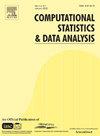Manifold-valued models for analysis of EEG time series data
IF 1.6
3区 数学
Q3 COMPUTER SCIENCE, INTERDISCIPLINARY APPLICATIONS
引用次数: 0
Abstract
EEG (electroencephalogram) records brain electrical activity and is a vital clinical tool in the diagnosis and treatment of epilepsy. Time series of covariance matrices between EEG channels for patients suffering from epilepsy, obtained from an open-source dataset, are analysed. The aim is two-fold: to develop a model with interpretable parameters for different possible modes of EEG dynamics, and to explore the extent to which modelling results are affected by the choice of geometry imposed on the space of covariance matrices. The space of full-rank covariance matrices of fixed dimension forms a smooth manifold, and any statistical analysis inherently depends on the choice of metric or Riemannian structure on this manifold. The model specifies a distribution for the tangent direction vector at any time point, combining an autoregressive term, a mean reverting term and a form of Gaussian noise. Parameter inference is performed by maximum likelihood estimation, and we compare modelling results obtained using the standard Euclidean geometry and the affine invariant geometry on covariance matrices. The findings reveal distinct dynamics between epileptic seizures and interictal periods (between seizures), with interictal series characterized by strong mean reversion and absence of autoregression, while seizures exhibit significant autoregressive components with weaker mean reversion. The fitted models are also used to measure seizure dissimilarity within and between patients.
脑电时序数据分析的流形值模型
脑电图(EEG)记录脑电活动,是诊断和治疗癫痫的重要临床工具。分析了从开源数据集中获得的癫痫患者脑电图通道间协方差矩阵的时间序列。目的是双重的:开发一个具有不同可能模式的脑电图动力学可解释参数的模型,并探索在多大程度上建模结果受到施加在协方差矩阵空间上的几何选择的影响。固定维数的全秩协方差矩阵空间形成光滑流形,任何统计分析本质上都依赖于该流形上度量结构或黎曼结构的选择。该模型结合了一个自回归项、一个均值回归项和一种高斯噪声形式,指定了任意时间点切方向向量的分布。参数推理通过极大似然估计进行,我们比较了在协方差矩阵上使用标准欧几里得几何和仿射不变几何得到的建模结果。研究结果显示癫痫发作与发作间期之间存在明显的动态关系,发作间期序列具有强均值回归和无自回归的特征,而癫痫发作表现出显著的自回归成分,均值回归较弱。拟合的模型也用于测量患者内部和患者之间的癫痫发作差异。
本文章由计算机程序翻译,如有差异,请以英文原文为准。
求助全文
约1分钟内获得全文
求助全文
来源期刊

Computational Statistics & Data Analysis
数学-计算机:跨学科应用
CiteScore
3.70
自引率
5.60%
发文量
167
审稿时长
60 days
期刊介绍:
Computational Statistics and Data Analysis (CSDA), an Official Publication of the network Computational and Methodological Statistics (CMStatistics) and of the International Association for Statistical Computing (IASC), is an international journal dedicated to the dissemination of methodological research and applications in the areas of computational statistics and data analysis. The journal consists of four refereed sections which are divided into the following subject areas:
I) Computational Statistics - Manuscripts dealing with: 1) the explicit impact of computers on statistical methodology (e.g., Bayesian computing, bioinformatics,computer graphics, computer intensive inferential methods, data exploration, data mining, expert systems, heuristics, knowledge based systems, machine learning, neural networks, numerical and optimization methods, parallel computing, statistical databases, statistical systems), and 2) the development, evaluation and validation of statistical software and algorithms. Software and algorithms can be submitted with manuscripts and will be stored together with the online article.
II) Statistical Methodology for Data Analysis - Manuscripts dealing with novel and original data analytical strategies and methodologies applied in biostatistics (design and analytic methods for clinical trials, epidemiological studies, statistical genetics, or genetic/environmental interactions), chemometrics, classification, data exploration, density estimation, design of experiments, environmetrics, education, image analysis, marketing, model free data exploration, pattern recognition, psychometrics, statistical physics, image processing, robust procedures.
[...]
III) Special Applications - [...]
IV) Annals of Statistical Data Science [...]
 求助内容:
求助内容: 应助结果提醒方式:
应助结果提醒方式:


